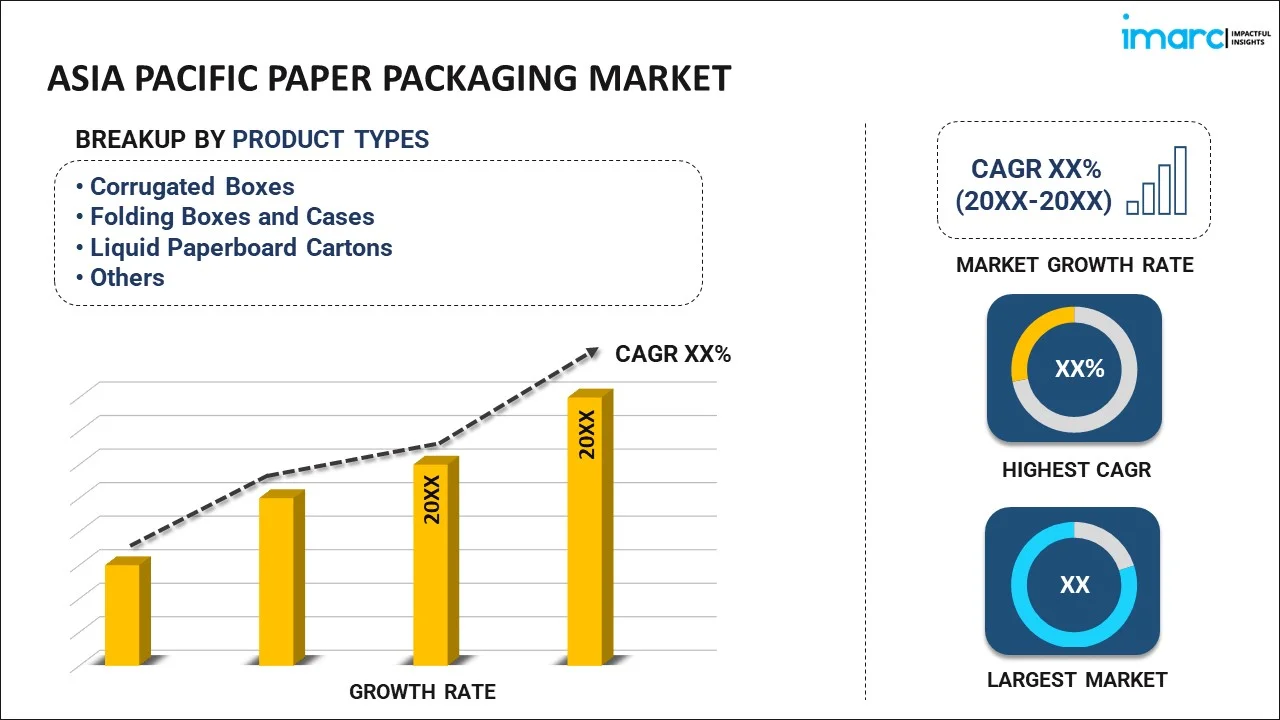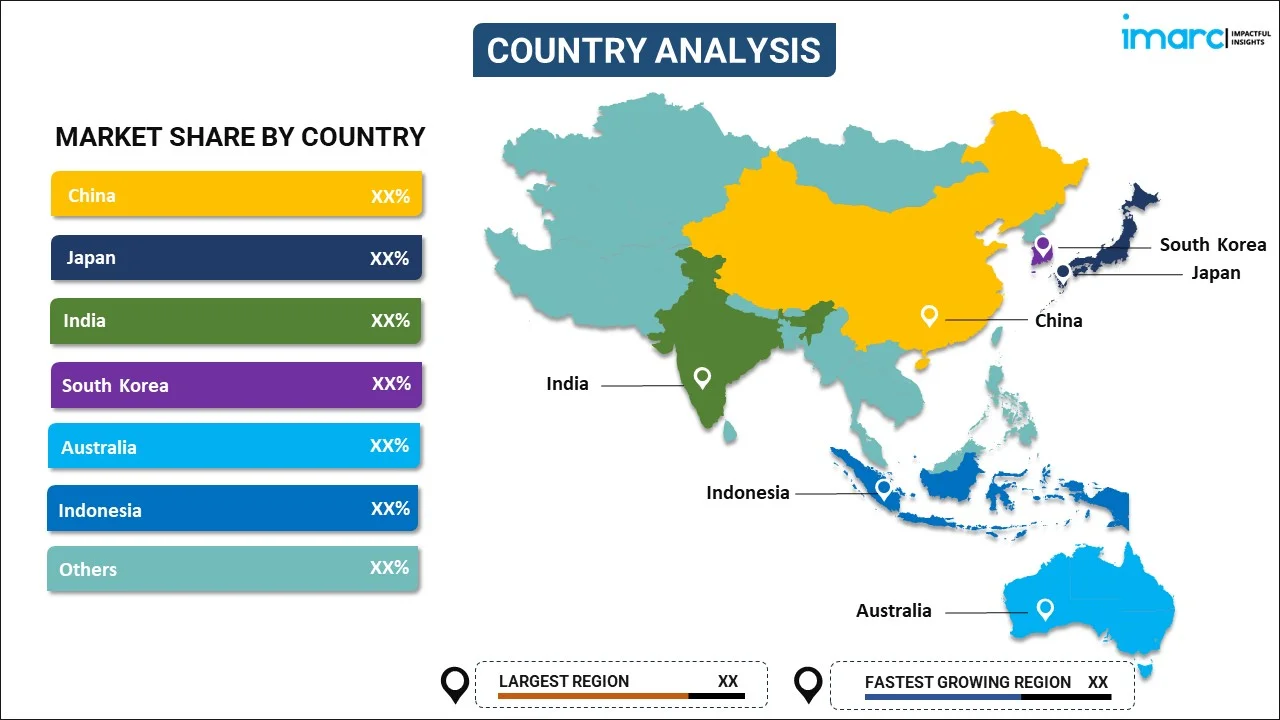
Asia Pacific Paper Packaging Market Report by Product Type (Corrugated Boxes, Folding Boxes and Cases, Liquid Paperboard Cartons, Paper Bags and Sacks, and Others), Grade (Solid Bleached, Coated Recycled, Uncoated Recycled, and Others), Packaging Level (Primary Packaging, Secondary Packaging, Tertiary Packaging), End Use Industry (Food, Beverages, Personal Care and Home Care, Healthcare, and Others), and Country 2025-2033
Market Overview:
The Asia Pacific paper packaging market size reached USD 176.5 Billion in 2024. Looking forward, IMARC Group expects the market to reach USD 233.2 Billion by 2033, exhibiting a growth rate (CAGR) of 3.08% during 2025-2033.
|
Report Attribute
|
Key Statistics
|
|---|---|
|
Base Year
|
2024
|
|
Forecast Years
|
2025-2033
|
|
Historical Years
|
2019-2024
|
|
Market Size in 2024
|
USD 176.5 Billion |
|
Market Forecast in 2033
|
USD 233.2 Billion |
| Market Growth Rate (2025-2033) | 3.08% |
Paper packaging is a method of transporting, preserving and protecting various items using rigid and flexible packaging products. It is durable, sturdy, lightweight, versatile and highly customizable. As a result, it is extensively utilized in the packaging of glassware, medicines, food products, beverages, electronics, perishables and toiletries across the Asia Pacific region.
Rapid urbanization, along with inflating disposable incomes, represents one of the key factors strengthening the growth of the market in the Asia Pacific region. Apart from this, paper packaging finds extensive applications in the personal care, healthcare, homecare and retail sectors. Furthermore, governments of several countries in the region are banning the usage of single-use plastics, which is encouraging individuals and businesses to use eco-friendly packaging solutions. However, the coronavirus disease (COVID-19) outbreak and consequent lockdown restrictions across the region have resulted in supply chain disruptions and the temporary halt of operations at manufacturing units. Nonetheless, the paper packaging market is anticipated to witness growth on account of the boosting sales of e-commerce platforms and the escalating demand for different packaging solutions.
Key Market Segmentation:
IMARC Group provides an analysis of the key trends in each segment of the Asia Pacific paper packaging market report, along with forecasts at the regional and country levels from 2025-2033. Our report has categorized the market based on product type, grade, packaging level and end use industry.
Breakup by Product Type:

- Corrugated Boxes
- Folding Boxes and Cases
- Liquid Paperboard Cartons
- Paper Bags and Sacks
- Others
Breakup by Grade:
- Solid Bleached
- Coated Recycled
- Uncoated Recycled
- Others
Breakup by Packaging Level:
- Primary Packaging
- Secondary Packaging
- Tertiary Packaging
Breakup by End Use Industry:
- Food
- Beverages
- Personal Care and Home Care
- Healthcare
- Others
Breakup by Country:

- China
- Japan
- India
- South Korea
- Australia
- Indonesia
- Others
Competitive Landscape:
The competitive landscape of the industry has also been examined along with the profiles of the key players.
Report Coverage:
| Report Features | Details |
|---|---|
| Base Year of the Analysis | 2024 |
| Historical Period | 2019-2024 |
| Forecast Period | 2025-2033 |
| Units | Billion USD |
| Segment Coverage | Product Type, Grade, Packaging Level, End Use Industry, Country |
| Countries Covered | China, Japan, India, South Korea, Australia, Indonesia, Others |
| Customization Scope | 10% Free Customization |
| Post-Sale Analyst Support | 10-12 Weeks |
| Delivery Format | PDF and Excel through Email (We can also provide the editable version of the report in PPT/Word format on special request) |
Key Questions Answered in This Report:
- How has the Asia Pacific paper packaging market performed so far and how will it perform in the coming years?
- What has been the impact of COVID-19 on the Asia Pacific paper packaging market?
- What are the key regional markets?
- What is the breakup of the market based on the product type?
- What is the breakup of the market based on the grade?
- What is the breakup of the market based on the packaging level?
- What is the breakup of the market based on the end use Industry?
- What are the various stages in the value chain of the industry?
- What are the key driving factors and challenges in the industry?
- What is the structure of the Asia Pacific paper packaging market and who are the key players?
- What is the degree of competition in the industry?
Need more help?
- Speak to our experienced analysts for insights on the current market scenarios.
- Include additional segments and countries to customize the report as per your requirement.
- Gain an unparalleled competitive advantage in your domain by understanding how to utilize the report and positively impacting your operations and revenue.
- For further assistance, please connect with our analysts.
 Inquire Before Buying
Inquire Before Buying
 Speak to an Analyst
Speak to an Analyst
 Request Brochure
Request Brochure
 Request Customization
Request Customization




.webp)




.webp)












